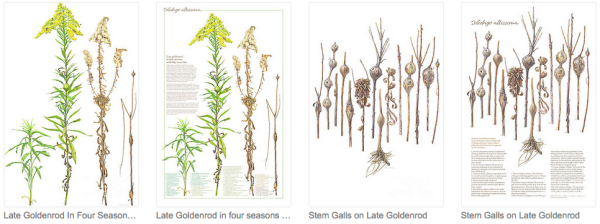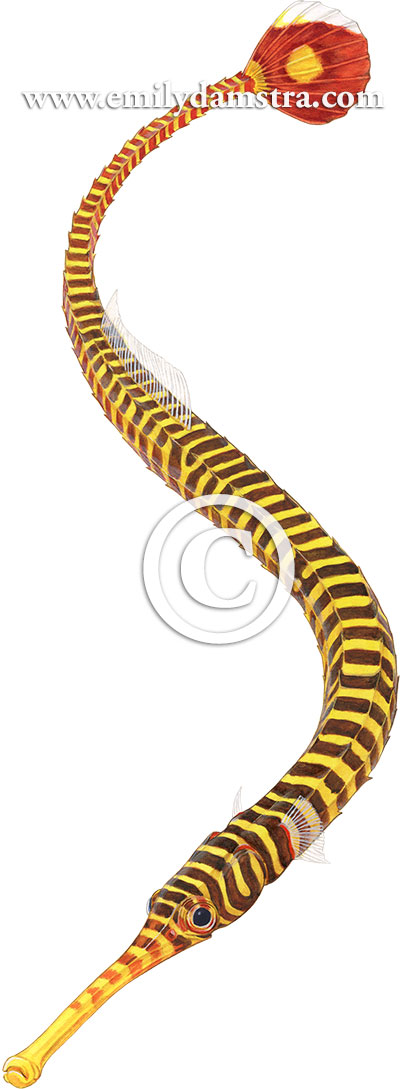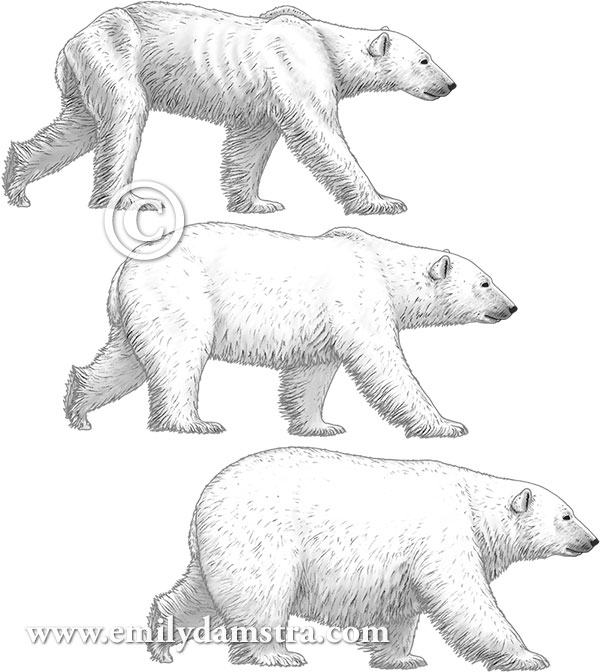New website and blog! A brief housekeeping post…
Dear Readers,
At long last, I have a new website. I really liked my old site and it served me well for 11 years. However, the ways people view online content have changed and I needed a responsive site with larger images. My new site – still at emilydamstra.com – is up and running though I still have many images to upload and a few kinks to work out. Please check back in a few weeks for more content.
This news blog will be integrated into my new site. The new URL is: emilydamstra.com/news
To the e-mail subscribers and followers of this blog, there is way I can transfer your subscription to the blog at my new site, so if all goes well you won’t need to do anything to continue your subscription. (If all does not go as planned, I’ll be in touch or you can re-subscribe at the new blog link above).
Thank you very much for following.
Emily
Six illustrations on display at the Grimsby Public Art Gallery
This past weekend I attended the Opening Reception for the 2016 Exhibit of the Southern Ontario Nature and Science Illustrators at the Grimsby Public Art Gallery in Southern Ontario.
I have six pieces in this exhibit, including these two goldenrod paintings, two of my recent marine life illustrations, my Common raven painting, and my Princess Point illustration.
They are on the back wall:
The Gallery is a lovely venue, and its staff did a fantastic job setting up the exhibit.
Just before one enters the Gallery there’s a small table with SONSI members’ business cards or post cards on it. Upon entering the exhibit space, one sees a table featuring publications that include the work of SONSI members. Coincidentally, our exhibit went up just before Science Literacy Week, so this table was the perfect tie-in.
A number of people from the local community came to the event, and the Gallery’s Director Rhona Wenger warmly welcomed everyone.
This exhibit is up until November 6, 2016.
Goldenrod prints
The two goldenrod illustrations mentioned in my last post are available as fine art prints, with or without interpretive text. The illustrations are printed at actual size and are offered on a variety of papers. I ordered one on Archival Matte paper to test the service and was very pleased with the print and paper quality. The prints are available from Fine Art America here. At that link you’ll find an option to zoom in and see details of the illustrations. If you order a print that does not have text identifying what is illustrated, you can download a document to help you interpret the illustration: just visit the Downloads link at the top of this page.
Canadians: The prints and posters are shipped from within Canada so postage fees aren’t horrendous and there are no issues with cross-border duties. (Most of the other products do not ship from within Canada).
There are also fulfillment centers in the USA, UK, Europe, and Australia.
Goldenrod
It’s late summer and the goldenrods are in bloom! These glorious bright yellow flowers are the crown jewels of summer, in my opinion. Seeing fields of them fills me with joy. To those suffering from hay fever this time of year: Please don’t mistakenly blame goldenrod for your suffering. It is the concurrently blooming ragweed that makes you sneeze. Ragweed has inconspicuous green flowers that are wind pollinated, hence the pollen in the air. Goldenrod has heavier pollen; it relies on insects for pollination. And numerous insects rely on goldenrod – so many in fact, that goldenrod may be considered a “biodiversity superhero.”
An interest in the insects and other organisms associated with goldenrod and their role in supporting other wildlife inspired me to apply for a research grant from the Access Copyright Foundation in order to study and illustrate them. That year-long project is now complete and the resulting illustration is below.
This life-size (approx. 36 in. tall) painting of Solidago altissima shows four ramets (individuals in a group of clones) – one for each season. Among the leaves, flowers, and stems are signs of 43 species of insects, three spiders, two fungi, and one snail. Nearly all are species that I personally observed during many hours of observations in the field; two are species that I did not see but that are known to depend on Late Goldenrod. There were many other species I observed or read about that I did not include because the goldenrod would have looked ridiculously overloaded.
I’ll post more information and close-up images in the weeks and months to come.
My research for that illustration piqued my interest in galls, which are abnormal growths of plant tissue caused by (in this case) insects. Seven species of flower, leaf, and stem gallers make an appearance in the illustration above. However, I wanted to delve deeper so I created a second illustration to show the surprising variety of galls that occur on stems of Solidago altissima. Galls from seven different insect species are represented here, with more than one example of some:
The illustrations are available as prints, with or without interpretive text. See here.
A stream restoration, illustrated
This year I had the pleasure of working the City of Kitchener to help communicate the reasons for and impact of a major stream restoration in one of their urban parks. Before the restoration, the stream sped its way through a concrete channel:
After the City restored the streambed to its more natural, winding state, the waterway became more habitable by wildlife such as the pumpkinseed sunfish. The stream also began depositing sediment along its banks rather than carrying it all the way to the lake in Victoria Park and problematically dumping it there. Another significant benefit of the restoration is the aesthetic appeal of the more natural watercourse:
These illustrations will appear on an interpretive sign in Filsinger Park.
Today’s issue of the weekly science journal Nature includes an excellent article about the value of science illustration. You can read it here.
The author writes about specific collaborations between researchers and illustrators to illustrate the idea that the benefits of a good illustration are worth an investment of time and money:
Visually stunning representations that result from collaborations between scientists and artists can grab millions of online views, and attract a much wider audience than a non-illustrated paper, both of which are particularly useful for researchers whose grant applications or funding proposals require them to show a public-outreach component. They are also more likely to be written about and shared digitally, helping to raise the visibility of a scientist’s work, attract more students to a lab, boost career standing and improve chances of garnering funding. They can even inspire new experiments — or reveal gaps in knowledge.
One example cited in the article is my collaboration with scientist Jessica Linton; you can see the resulting illustration and read about it here.
Spotlight on sea creatures
This year I’ve been illustrating a variety of marine animals for the scuba diving magazine Sport Diver. For each issue, Richard Smith writes an article focusing on a different animal or group of animals. He offers interesting facts and stories about the organism(s), and my illustrations accompany them. Here are the paintings I’ve done so far, all of them with watercolor and gouache paints:
Two new coins – hawk and cougar
I designed these two new releases from the Royal Canadian Mint:
The background field on this silver bullion coin has fine lines radiating from the center, which is a nice effect (though a bit difficult to capture in a photograph). Bullion coins are available from coin dealers but not directly from the Mint.
You can see the full specs for this silver coin here. The box it comes in shows my original drawing on the front:
Polar Bear Fatness Index
Last year I had the opportunity to produce some illustrations for Polar Bears International, an organization devoted to conserving polar bears through research and education. My illustrations of polar bears in various states of fitness became part of a scorecard used to assess body condition. It helps people who observe a bear to visually determine its body condition in the most standardized way possible. Below are three of the ten illustrations. Happy International Polar Bear Day (Feb. 27)!
An Arctic hare at full speed, in silver
Last year I received an invitation from the Royal Canadian Mint last year to submit a coin design featuring a Canadian hare in action. I thought it would be interesting to show an arctic hare (Lepus arcticus) running at full speed, a behavior employed when a predator is in pursuit.
The 34 mm silver coin has just been released:
I illustrated a ground-level view of an adult hare sprinting across rocky tundra as it attempts to outrun or outmaneuver the pursuing arctic wolf. The significant distance between the wolf and hare adds to the uncertainty about how the chase concludes. Arctic hares are an important food source for arctic wolves, which are the only predators that would typically hunt adult hares. Even so, the outcome of the pursuit is just as likely to be that the wolf gives up, unable to catch the speedy and evasive hare. I think it’s a dignified way to show the hare because running fast is something that it’s well-adapted to do; if it didn’t have a chance against the wolf then arctic hares would have become extinct long ago.
The certificate that comes with the coin shows my original drawing:


















